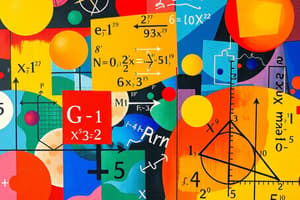Podcast
Questions and Answers
Which of the following represents a branch of Mathematics that deals with shapes and their properties?
Which of the following represents a branch of Mathematics that deals with shapes and their properties?
- Calculus
- Geometry (correct)
- Algebra
- Statistics
What is the main focus of calculus in mathematics?
What is the main focus of calculus in mathematics?
- Calculation of probabilities
- Solving quadratic equations
- Understanding statistical data
- Determining area under curves (correct)
What property indicates that the order of addition does not change the sum?
What property indicates that the order of addition does not change the sum?
- Commutative Property (correct)
- Distributive Property
- Associative Property
- Identity Property
What does the acronym PEMDAS stand for in relation to order of operations?
What does the acronym PEMDAS stand for in relation to order of operations?
Which tool is essential for graphically representing functions?
Which tool is essential for graphically representing functions?
In statistics, what are the measures of central tendency?
In statistics, what are the measures of central tendency?
What does discrete mathematics primarily focus on?
What does discrete mathematics primarily focus on?
What is a common application of mathematics in daily life?
What is a common application of mathematics in daily life?
Flashcards are hidden until you start studying
Study Notes
Key Concepts in Mathematics
Branches of Mathematics
-
Arithmetic
- Basic operations: addition, subtraction, multiplication, division.
- Concepts of integers, fractions, decimals, and percentages.
-
Algebra
- Variables, constants, coefficients.
- Expressions, equations, and inequalities.
- Functions and graphs.
- Quadratic equations and factoring.
-
Geometry
- Points, lines, angles, shapes.
- Area and perimeter of 2D shapes.
- Volume and surface area of 3D shapes.
- Theorems (e.g., Pythagorean theorem).
-
Trigonometry
- Sine, cosine, tangent functions.
- Right triangles and the unit circle.
- Trigonometric identities and equations.
-
Calculus
- Differentiation: finding the rate of change.
- Integration: finding the area under curves.
- Limits and continuity.
-
Statistics
- Data collection and analysis.
- Measures of central tendency: mean, median, mode.
- Probability concepts and distributions.
-
Discrete Mathematics
- Study of countable, distinct objects.
- Topics include combinatorics, graph theory, and algorithms.
Key Mathematical Principles
- Order of Operations: PEMDAS (Parentheses, Exponents, Multiplication and Division, Addition and Subtraction).
- Properties of Numbers:
- Commutative, associative, and distributive properties.
- Functions:
- Definition: a relation that assigns exactly one output for each input.
- Types: linear, quadratic, polynomial, exponential.
Mathematical Tools
- Calculators: Used for complex calculations.
- Graphing Tools: For visual representation of functions and data.
- Software: Programs like MATLAB, Python for advanced computations.
Problem-Solving Strategies
- Understand the Problem: Read carefully and determine what is being asked.
- Devise a Plan: Outline steps to solve the problem.
- Execute the Plan: Carry out the steps.
- Review/Check: Verify the solution and check for errors.
Applications of Mathematics
- In Daily Life: Budgeting, cooking, shopping.
- In Science and Engineering: Calculations for design, physics equations.
- In Economics: Statistical analysis, financial modeling.
Study Tips
- Practice Regularly: Solve a variety of problems to strengthen understanding.
- Use Visual Aids: Diagrams, graphs, and charts can clarify concepts.
- Collaborate: Study groups can enhance learning through discussion.
Important Formulas
- Area of a rectangle: A = length × width.
- Volume of a cylinder: V = πr²h.
- Quadratic formula: x = (-b ± √(b²-4ac)) / 2a.
- Slope of a line: m = (y2 - y1) / (x2 - x1).
Branches of Mathematics
- Arithmetic: Covers basic operations and concepts such as integers, fractions, decimals, and percentages.
- Algebra: Involves variables and constants; deals with expressions, equations, inequalities, functions, graphs, and quadratic equations.
- Geometry: Studies points, lines, angles, shapes, and calculates area, perimeter, volume, and surface area; includes the Pythagorean theorem.
- Trigonometry: Focuses on sine, cosine, and tangent functions, right triangles, the unit circle, and trigonometric identities.
- Calculus: Investigates differentiation for rates of change, integration for area under curves, and concepts of limits and continuity.
- Statistics: Engages in data collection and analysis, measures of central tendency (mean, median, mode), and probability distributions.
- Discrete Mathematics: Explores countable objects including combinatorics, graph theory, and algorithms.
Key Mathematical Principles
- Order of Operations: Follow PEMDAS (Parentheses, Exponents, Multiplication and Division, Addition and Subtraction) for correct calculations.
- Properties of Numbers: Includes commutative, associative, and distributive properties aiding in arithmetic operations.
- Functions: Defined as relations assigning a single output for each input; categories include linear, quadratic, polynomial, and exponential functions.
Mathematical Tools
- Calculators: Essential for performing complex mathematical calculations efficiently.
- Graphing Tools: Facilitate the visual representation of functions and datasets for better understanding.
- Software: Applications like MATLAB and Python support advanced computations and modeling.
Problem-Solving Strategies
- Understand the Problem: Read thoroughly to identify what is required.
- Devise a Plan: Create a step-by-step outline to approach the solution.
- Execute the Plan: Implement the outlined steps to find the solution.
- Review/Check: Confirm the accuracy of the solution and correct any mistakes.
Applications of Mathematics
- In Daily Life: Mathematics is vital for budgeting, cooking, and shopping decisions.
- In Science and Engineering: Mathematics is essential for design calculations and solving physics equations.
- In Economics: Utilizes statistical analysis and financial modeling to inform decisions.
Study Tips
- Practice Regularly: Engage with a variety of problems to enhance mathematical skills and comprehension.
- Use Visual Aids: Incorporate diagrams, graphs, and charts for a clearer understanding of concepts.
- Collaborate: Join study groups to improve learning through collaborative discussion and problem-solving.
Important Formulas
- Area of a Rectangle: ( A = \text{length} \times \text{width} )
- Volume of a Cylinder: ( V = \pi r^2 h )
- Quadratic Formula: ( x = \frac{-b \pm \sqrt{b^2 - 4ac}}{2a} )
- Slope of a Line: ( m = \frac{y_2 - y_1}{x_2 - x_1} )
Studying That Suits You
Use AI to generate personalized quizzes and flashcards to suit your learning preferences.




